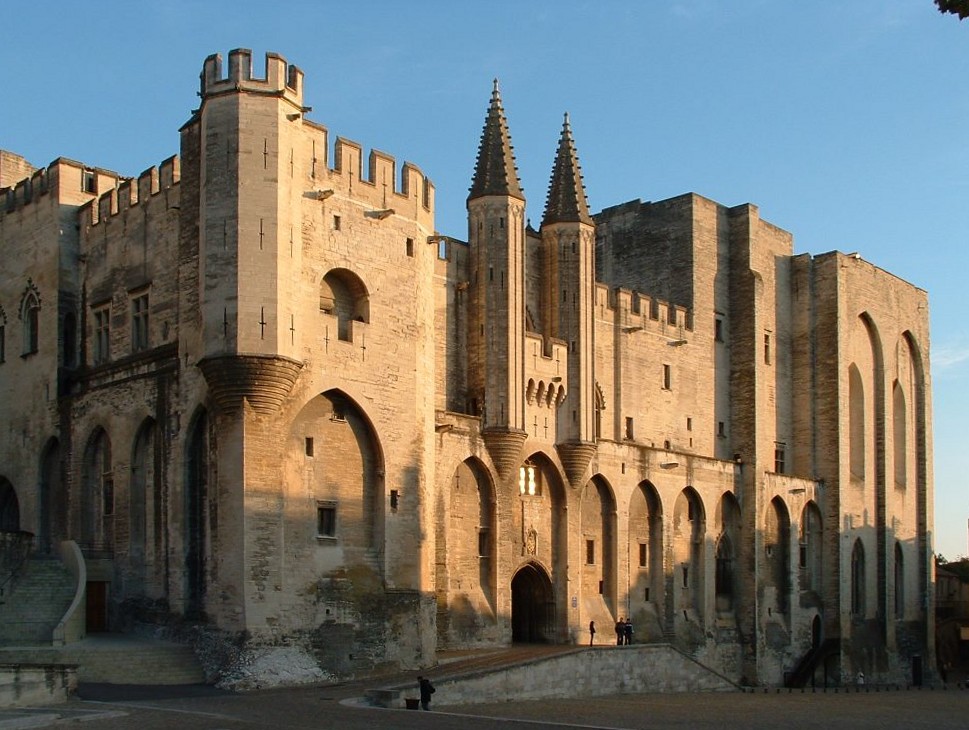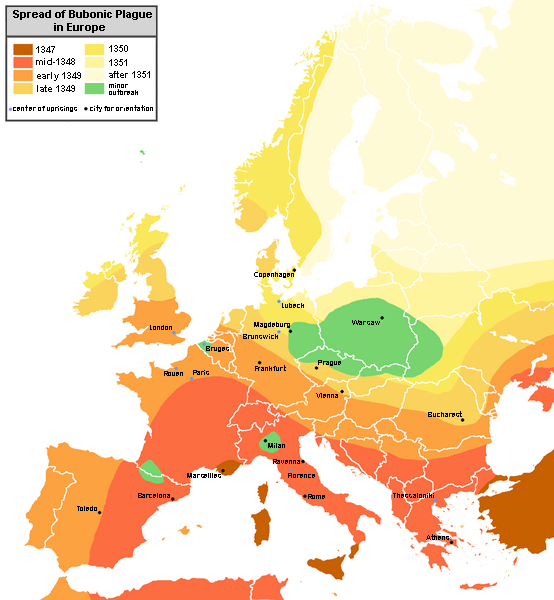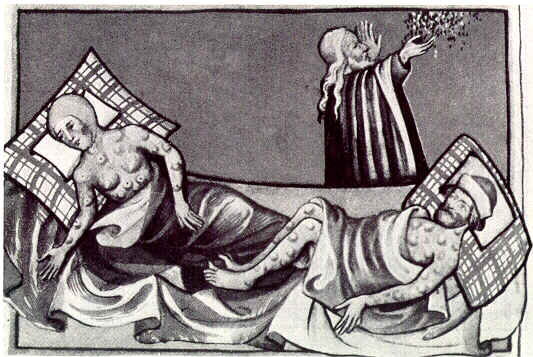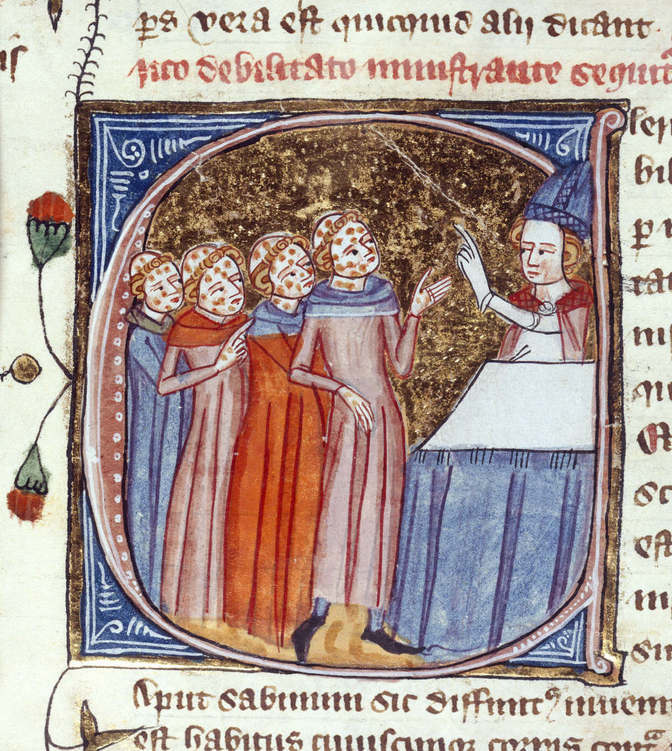7. THE HIGH MIDDLE AGES

THE CLOSE OF THE MIDDLE AGES
Mid-1300s
CONTENTS
 Marco Polo Marco Polo
 The "Babylonian Captivity" of the popes The "Babylonian Captivity" of the popes
in France (1309-1377)
 The Scots secure independence from The Scots secure independence from
England
 The First Phase (1337-1360) of the The First Phase (1337-1360) of the
"Hundred Years' War"
 The "Black Death" (1348-1351) The "Black Death" (1348-1351)
 The rising secular spirit in urban Europe The rising secular spirit in urban Europe
... and rural serfdom
 The rising threat in the East of the The rising threat in the East of the
Ottoman Turks
 The Papal Schism closes out the Middle The Papal Schism closes out the Middle
Ages (1377-1418)
The textual material on page below is drawn directly from my work
A Moral History of Western Society © 2024, Volume One, pages 267-274.
|
Marco Polo's amazing discovery of another world to the East
Around the year 1300, Westerners were very surprised to learn from an account, The Travels of Marco Polo,
of a world in the Far East largely unknown to Westerners … in
particular, the very advanced civilization of China. Marco Polo's
tradesmen father and uncle had first made the journey east from their
home in Venice in the 1260s, meeting Chinese emperor Kublai Khan in the
process. When then in 1271 they returned to China at the
emperor's request (and Pope Gregory X's support), they had Marco with
them – the young man impressing the emperor so much that he had him
remain in China to serve as an imperial emissary. Marco thus was
sent on many diplomatic missions in and around the Chinese
Empire. Consequently, over the next 17 years he became quite
familiar with China and its ways. Then he and his father and
uncle had the additional opportunity to explore the neighboring
societies of Vietnam, Burma, Indonesia, India, Sri Lanka and Persia …
before returning to Venice (in 1295) after 24 years away from their
home.
Upon their arrival back in Venice, Marco found himself involved in a
very vicious trade war going on at the time with Genoa … and got
captured and imprisoned in the process. But this did give him the
opportunity to spend that time dictating the account of his travels to
his cellmate. He was finally released in 1299 and returned
to a very palatial home – thanks to the wealth he and his family had
acquired in Eastern gems.
Very importantly, his depiction of a highly civilized China – and the
Far East in general – awakened a Western society already highly stirred
by a rising curiosity about the surrounding world … and all of its
fantastic material offerings. This would merely add to the
dynamic that was taking Europe out of its humbler Christian ways … and
ever-deeper into the world of material wealth and power.
|
THE "BABYLONIAN
CAPTIVITY" OF THE POPES IN FRANCE |
We
have seen how clearly the papal office of the Bishop of Rome had long
been the center of social-cultural politics – even military
politics. During the crusades European kings had served
essentially as military commanders for Christian armies understood to
be operating under the authority of the Pope. Only the crusading
Holy Roman Emperor Frederick II acted independently of the Pope (for
which he was excommunicated not once but twice!).
With the close of the crusades in the late 1200s this dynamic
changed. Ambitious kings and princes (and even powerful Italian
families) began to operate increasingly independently in their own
territories – in disregard of the presumed unity of Christendom
represented by the Church and its papal leadership. Popes found
themselves in opposition to many of these new authorities – a situation
which politicized heavily the papal office. Excommunications were
imposed – and then lifted – against kings and ministers of state when
the interests of the papacy and these rising authorities either clashed
or conformed.
A number of diplomatic crises plus local circumstances in Rome upset
greatly the political standing of the Roman papacy: infighting between
two powerful Roman families (the Orsini and Colonna) over control of
the papacy, the increasing influence of French clergy in the Papal
Curia, the effort of French King Philip IV to have Pope Boniface
arrested and brought to France for "heresy" in 1303 (but Boniface died
soon after this assault) and finally the election of a French pope
(Clement V) in 1305. This resulted in the decision of the Curia that
year to move the papal office to France – eventually in 1309 to the
city of Avignon in southern France. Here supposedly the pope
would be under the French king's "protection." This begins the
period of the papacy often termed the "Babylonian Captivity"!
Pope Clement was clearly a tool of French king Philip IV and agreed to
the destruction of the Knights Templars, a very wealthy crusading order
whose land and financial assets in France Philip IV coveted
deeply. Clement also became deeply engaged in battles with the
growing commercial empire of Venice … and led a brutal crusade at the
beginning of the 1300s against some of the "Dulcinian heretics" whose
Franciscan-inspired spirituality was deemed offensive to the church.
Then popes after Clement integrated the papacy more and more with the
interests of the French monarchy. Thus as the 1300s rolled along
the popes gave more the appearance of being mere participants or even
pawns in the political struggles of Europe – than they did of grand
leaders of Europe's huge religious community.
Then when in 1377 the pope was finally returned to Rome, several
"popes" competed for official recognition as the supreme head of the
Roman Church. This continued to worsen the spiritual dignity of the
papacy, whose image dropped decidedly in the eyes of the faithful – and
remained at a low for quite some time.
|

The Papal Palace at
Avignon
THE SCOTS SECURE INDEPENDENCE FROM ENGLAND |
Edward
II of England (r. 1307-1327) proved inept (and corrupt) … losing
the Battle of Bannockburn (1314) to Scottish leader Robert the Bruce –
and thus securing Scotland's independence from England, with Robert now
serving as Scottish king … confirmed in 1324 by Pope John XXII's decree
and further secured with a new Scottish alliance with France in
1327.
By this time the English were so tired of Edward that they (aided by
Edward's wife Isabella … who was also French King Philip IV's daughter)
forced him to abdicate that same year in favor of his son Edward
III. He was subsequently murdered … probably under the orders of
Isabella.
|
THE FIRST PHASE (1377-1360) OF THE "HUNDRED YEARS' WAR" |
The
"Hundred Years' War" – actually a series of three wars, interspersed
with times of truce – was basically an ongoing battle between the
Plantagenet and Valois families over the question of the right to
govern France. It is often identified as a battle between the
English and the French, which is what it eventually became as
Plantagenet troops and support took on an increasingly English
nationalist character, with the Valois increasingly appearing to be the
more "French" of the two contenders.
The Plantagenet family held the peculiar position of being both
vassals or barons under the kings of France, yet – since the Norman
victory over the Saxons in England in 1066 – at the same time kings by
their own right in England. The two families were also connected
by lineage or mutual descent from the Capetian royal family ruling
France – starting up a bitter contest between the two families when the
last king of the Capetian line ruling France died without any direct
heirs. At first the Plantagenets (led by English King
Edward III) Edward III attempted to assert his right to the French
throne … he being the nearest male in line to that throne through his
mother Isabella, the only sister of the just deceased French King
Charles IV. But ultimately he acknowledged the Valois claim to
the French throne by way of his cousin, Philip VI. But in 1337,
Edward decided to press his own claim to the French throne when Philip
moved to support the Scottish in their long-standing war with the
English. Thus began the first phase of a contest that would span
five generations of these two families.
Edward III (1327-1377)
offered England another long period of rule … though he was deeply
challenged during much of that time by that "Hundred Years' War.
Initially, during the "First Phase" (1337-1360) of the war, it appeared
that Edward would succeed in his bid for the French throne – as the
fortunes of war favored his forces greatly in battle after
battle. His son, Prince Edward "The Black Prince," was given
command of his Plantagenet or "English" forces … and defeated the
Valois or "French" forces soundly at Crécy (1346) and Poitiers
(1356). And the younger Edward's path to securing his position as
Prince of Aquitaine and Gascony in the South of France involved him in
many other successful (and highly destructive) battles with the Valois
forces.
But the intervention of the Great Plague (or "Black Death") hit England
– as all of Europe – very hard … killing much of the English
momentum. But the war then resumed as England recovered …
resulting ultimately in the capture by Prince Edward in 1356 of French
King John II … who, however, was merely held for ransom. But it
was a most humiliating defeat for the French.
Then in 1360 a strange hail storm killed over 1,000 of the English
troops as they were undertaking the siege of Chartres … on their way to
then seizing Paris. But the storm so devastated the English army
(the largest loss of life in the war so far) that King Edward was
forced to accept terms of peace with France. This would bring
this first phase of the Hundred Years' War to a close.
|
THE "BLACK
DEATH" (1348 to 1351) |
In
the mid-1300s the Black Death struck Europe – wiping out 25 million
people. It originated in Central Asia and made its way along the
silk route to Constantinople in early 1347. From there it was
brought to Sicily and Italy, spreading over Italy early the following
year, and from there quickly into France and southern England by the
summer of 1348. In Florence alone, it killed three-fourths of the
city's inhabitants. In England, in a 3-year period it wiped out
half of the population of 4 million people. After this a wave of
other epidemics swept a much-weakened Europe.1
Overall, the Black Death left Christian Europe shattered, economically,
socially, culturally … not to mention spiritually. Where was God
in all of this? Was he actually not the powerful God they had
been led to have full faith in? Or was he an angry God, angry at
the moral-political dissolution that had hit the Christian community …
especially at the level of its "Christian" leaders? What exactly
was one to make of this disastrous event?
The Church did not rebound well from the Black Death, having been able
to give neither explanation for nor relief from this mysterious
devastation. A lot of faith in the Christian cosmos was deeply
undercut by this tragedy. Worse, not able to account for the
cause of the tragedy, the Europeans’ frustration and wrath turned on
defenseless targets such as Jews, Gypsies, lepers and foreigners,
Europeans blaming them for having brought the disease. Whole
communities of European Jews were completely wiped out in the reaction.
Nonetheless Europe rebounded fairly quickly, though with a greatly depleted population.
1Waves
of attack by the plague would hit Europe again and again over the years
... though not with the severity of the 1350 Black Death ... though
very devastating and frustrating nonetheless. It would not be
until the 1600s that Europe would reach the populations size it had
before the Black Death.
 The spread of the Bubonic
Plague in Europe
The spread of the Bubonic
Plague in Europe

Illustration of bubonic
plague in the Taggenburg Bible

Monks, disfigured by
the plague, being blessed by a priest
From James Le Palmer, Omne
Bonum (London, 1360-1375)
THE RISING SECULAR SPIRIT IN URBAN EUROPE ... AND RURAL SERFDOM |
Urban optimism.
Indeed a secular spirit rising among the people – particularly those
living in the rapidly growing cities – was too strong to be long
intimidated by the calamities of the Black Death and the Babylonian
Captivity ... or the diminishing of sacred tradition caused by the
Papal Schism. As things actually turned out, many urban laborers
benefitted financially from the labor shortage caused by the Black
Death.
Indeed urban life tended to bounce back quickly in spirit ... and keep
moving forward, lured onward by a sense of better things lying ahead.
But rural serfdom (virtual slavery).
However, it must also be noted that in the feudal coountryside this
same labor shortage caused many feudal lords in fact to tighten up on
the ability of their peasants to shift around in the quest for better
conditions elsewhere.
In
England, efforts by landowners (including the church) to hold scarce
labor captive through a tightening of the laws permitting the peasants
to move on to new economic opportunities – instead gradually turning
the English free peasants into serfs – eventually produced a massive
uprising in East Central England known as the Peasants' Revolt
(1381). Although it was brutally suppressed, it left among the
commoners a legacy of discontent with the wealth of the landowners ...
and the church.
In Central and Eastern Europe the lords of the land now tended to lock
their vassals in place as rightless serfs ... whose social-political
status was now hardly different from that of a slave. |
THE RISING THREAT IN THE EAST OF THE OTTOMAN TURKS |
Osman I (1281-1326) founds the Ottoman Empire.
In 1281 a local Oghuz Turk took up his father’s position as bey
(governor) of a small beylic (Turkish state) in northwestern Anatolia
(modern-day Turkey) … very near the border of a weakening Byzantine
Empire. Choosing to take his aggressions out on the failing
Byzantine Empire rather than on his Turkish neighbors (the more usual
direction of Turkish military politics) he drew a large number of other
Turks to his cause – notably Ghazi warriors (volunteer militia)
abandoning what was by then a collapsing Seljuk empire – Osman building
up a very strong military in in the process. Thus he proceeded to
expand the boundaries of his own beylik … but also through diplomacy
and strategic marriages as well as by the engines of war. By 1299
he was ready to accept the title "Sultan of the Ghazis." Thus the
Ottoman Sultanate, the forerunner of the Ottoman Empire, was born (and
soon named after him).
Orhan and Murad I.
Osman’s son Orhan (1326-1362) and Orhan’s son Murad I (1362-1389)
continued the Ottoman expansion, Orhan taking Bursa with his Ghazi
troops, making it his new capital … very close to the Byzantine capital
at Constantinople. At this point the Byzantine power in Anatolia
was almost completely eradicated.
In taking power in 1362 Murad immediately conquered the city of
Adrianople, to the north of Constantinople, beginning the encirclement
of the Byzantine capital ... and the permanent move of the Ottoman
Sultanate onto the European continent. Murad turned this Balkan
city into his new capital in 1363 and renamed the city "Edirne."
He then began his expansion into neighboring Bulgarian and Serbian
lands, aided greatly by the internal divisions and infighting going on
within those two Christian societies … and by the pressures on the
Bulgarians coming from the Hungarians to the north and the Greeks
rising up in rebellion against the Serbs to the southwest. In
1387 his troops were able to seize from the Italian Venetian Empire the
strategic city of Thessaloniki sitting at the vital juncture of the
land of the Bulgarians, Serbs and Greeks.
Finally in 1389 at the battle of Kosovo, Murad’s new army, now including Janissary troops,2
was able to crush the Serbian army (though the Ottoman forces
themselves were greatly devastated by the battle), weakening the Serbs
so much that they soon accepted vassalage within the growing Ottoman
domain ... though Murad himself lost his life in the battle.
Bayezid I (1389-1403).
Bayezid gathered a massive army – interestingly made up of a large
number of Serbian and Byzantine soldiers – to consolidate his hold on
the remaining independent Turkish beyliks to the south of the Anatolian
peninsula. Meanwhile (1389-1395) his troops were active to the
north in Bulgaria and Wallachia (today’s southern Romania) … although
the Wallachians were able to hold him in check. And in 1395 he
laid siege to the Byzantine capital of Constantinople … but was unable
to breach its thick walls or cut off its supplies by sea – although a
Christian relief force – another "crusade" … led by the King of Hungary
– was defeated at Nicopolis (1396).
Tamerlane - A Step backward for the Ottomans.
The Ottoman assault on Constantinople continued until 1402 … when the
Ottoman troops were called back to Anatolia to hold off the
ever-expanding central-Asian realm of Timur (or "Tamerlane") … who had
allied with the local Turkish beys that had proven resentful of
Bayezid’s domination of Anatolia. At the Battle of Ankara (1402)
Bayezid was captured … and died the following year in captivity.
For a brief period (ten years) it looked as if the Ottoman threat to
Europe had been dismissed. But that was not to be. In the
next century (and after) the Ottoman Turks would play a major role in
European affairs.
2The
Janissaries constituted something of a new personal guard, in effect
slave soldiers who had been taken from Christian homes at an early age
and trained as Muslim warriors totally dedicated in life and death to
the Ottoman sultan. They proved to be very fierce warriors … even in
taking on the Christian world they had originally been born to.
THE PAPAL SCHISM CLOSES OUT THE MIDDLE AGES (1377 to 1418) |
When
in 1377 Pope Gregory returned the papal court to Rome, he soon died ...
and the College of Cardinals elected a new pope, whom they quickly grew
to dislike, and thus elected another pope. But the first pope
refused to step down ... and now there were two popes.
European princes and kings soon lined themselves behind one or another
candidate, making the papal schism even more catastrophic to the status
of the Church. Eventually there would be even other candidates
(and their political supporters) to step forward to claim the papal
position ... before a compromise was finally achieved at the Council of
Constance (1414-1418).
But Christianity, as the spiritual underpinning of the old Christian community, by that time had lost ground badly.
|

Go on to the next section: The European Renaissance
 Miles
H. Hodges Miles
H. Hodges
| | |


 Marco Polo
Marco Polo
 The "Babylonian Captivity" of the popes
The "Babylonian Captivity" of the popes The Scots secure independence from
The Scots secure independence from The First Phase (1337-1360) of the
The First Phase (1337-1360) of the The rising secular spirit in urban Europe
The rising secular spirit in urban Europe The rising threat in the East of the
The rising threat in the East of the The Papal Schism closes out the Middle
The Papal Schism closes out the Middle





